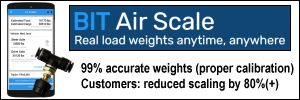Charlie Valentine spoke to us about a trailer connection problem he had early on in his owner-operator career.
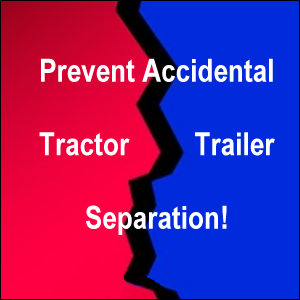 At the time he shared his story — when Mike drove for Epes Transport the second time — Charlie had 32 years of experience as an owner-operator.
At the time he shared his story — when Mike drove for Epes Transport the second time — Charlie had 32 years of experience as an owner-operator.
So obviously the problem didn’t dissuade him from pursuing a career in trucking.
But he shared the story so that others won’t repeat his mistake.
Advanced Warning from Someone Who Knew
As we recall it, his dad had warned him about the problems of backing under a trailer in the winter.
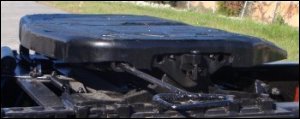 As we’re sure you know, a fifth wheel platform (shown here) slides under the trailer.
As we’re sure you know, a fifth wheel platform (shown here) slides under the trailer.
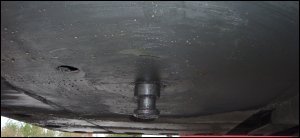 The trailer’s king pin fits into the fifth wheel so that the locking jaws firmly clamp around it.
The trailer’s king pin fits into the fifth wheel so that the locking jaws firmly clamp around it.
In the winter or other cold temperatures, the “platform grease” used on the fifth wheel can get really viscous.
When a professional truck driver is in the process of connecting trailer to truck, it can “feel” like the tractor is backed all the way under the trailer when it isn’t.
And therein lies the problem. It can be a “false positive connection.”
Only when the locking jaws of the fifth wheel have securely clamped around the kingpin — usually with a very audible “click” — is the trailer firmly attached.
A visual inspection is required.
How to Know You Have a Good Trailer Connection
It has been said that a picture is worth a thousand words. So, we will show you what we mean.
When the tractor is backed under the trailer all the way, the fifth wheel slides around the king pin.
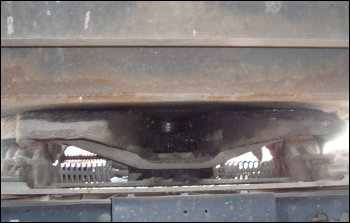 The locking jaws are supposed to clamp around the back of the king pin to hold it firmly in place.
The locking jaws are supposed to clamp around the back of the king pin to hold it firmly in place.
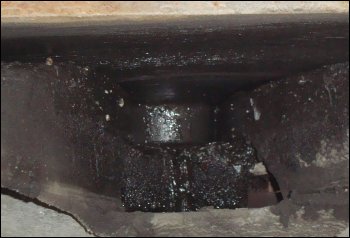
This is a close-up of the locking jaws around the king pin, meaning that the trailer is firmly attached.
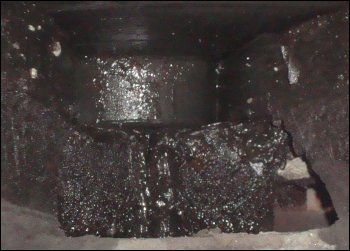 In yet a closer view, you can see the locking jaws clamped around the king pin when the trailer connection is complete.
In yet a closer view, you can see the locking jaws clamped around the king pin when the trailer connection is complete.
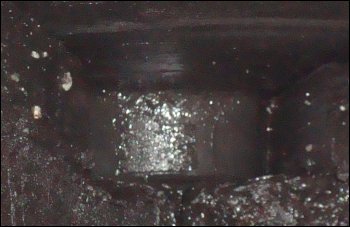 This is a magnification of the view of the trailer connection with the locking jaws around the king pin.
This is a magnification of the view of the trailer connection with the locking jaws around the king pin.
If you can’t see it well on your rig, you might want to get a good flashlight.
Challenges of Ensuring a Great Trailer Connection
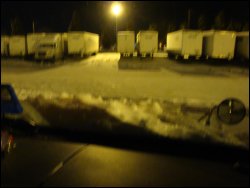 Backing under a trailer at night when it has been snowing can be especially dangerous.
Backing under a trailer at night when it has been snowing can be especially dangerous.
Not only must you be concerned about getting good traction so as to back all the way under the trailer, but there may be a build up of snow or ice under the trailer that may make connecting difficult.
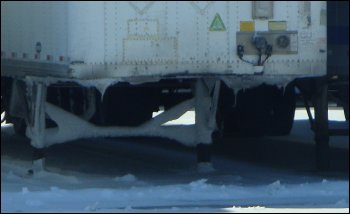
Here’s an example of a trailer that has a build up of snow and ice underneath that can potentially hinder making a good trailer connection.
What Happened to Charlie?
It’s one thing to hear a word of instruction and another thing to follow through.
Charlie picked up a trailer in the winter and headed for the New Jersey Turnpike.
When he made the turn to get onto the big road, he experienced a trailer separation!
As it turned out, he hadn’t actually backed all the way under the trailer far enough for the locking jaws to clamp around the king pin.
The platform grease was cold and sticky enough to “grip” the trailer on the tractor as long as the rig was going straight, but as soon as he made a turn, that “grip” turned loose!
The trailer connection he thought he had was a “false positive connection.”
This kind of accident was also noted in this article(1):
But another thing [truck driver Ron] Rosenberg said semi drivers need to check when the temperature drops is their fifth wheel plate and kingpin. That’s the part that connects the trailer to their cab.
“In the wintertime the grease gets real thick so you have to make sure that the pin gets locked and with the grease in their sometimes the doglegs move slower around the pin. It won’t get all the way around,” he said.
And even though it’s a rare occurrence, drivers check it frequently.
“That would be every truck driver’s nightmare, if one of these trailers would come off,” said Rosenberg.
The trailer separation Charlie had sure shocked him.
From that point on, he always made sure to check “for sure” if he had a good trailer connection.
Video of Trailer Separation
![]() Money saving tip: Listening for the click may not be enough.
Money saving tip: Listening for the click may not be enough.
Avoid a trailer separation accident by making sure you have a good trailer connection.
How?
“Get Out and Look” at the locking jaws of your fifth wheel around your trailer’s king pin.
And in case you hadn’t noticed, it’s dark under there!
To assist, make sure you use a flashlight with a good beam, and be sure to keep a spare set of flashlight batteries at all times.
This goes for every trailer that you pull with your rig.
If you haul doubles, you have to check two king pins, one on your tractor and the other on your converter gear (or dolly).
If you haul triples, check all three trailer connections.
In the winter, you may want to check more often.
Don’t forget to give a good “power pull.”
However, if you’re in snow or ice, you could end up literally just spinning your wheels.
If this happens to you, using kitty litter for traction can help.
Return from Trailer Connection and Separation: Trucker Winter Driving Tips to our Tricks of the Trade page or our Truck Drivers Money Saving Tips home page.
Reference
www.kimt.com/content/localnews/iowanews/story/Semi-Safety-on-Winter-Roads/iw1P2ts1aEqVbmYcVEGzcA.cspx (no longer online)

